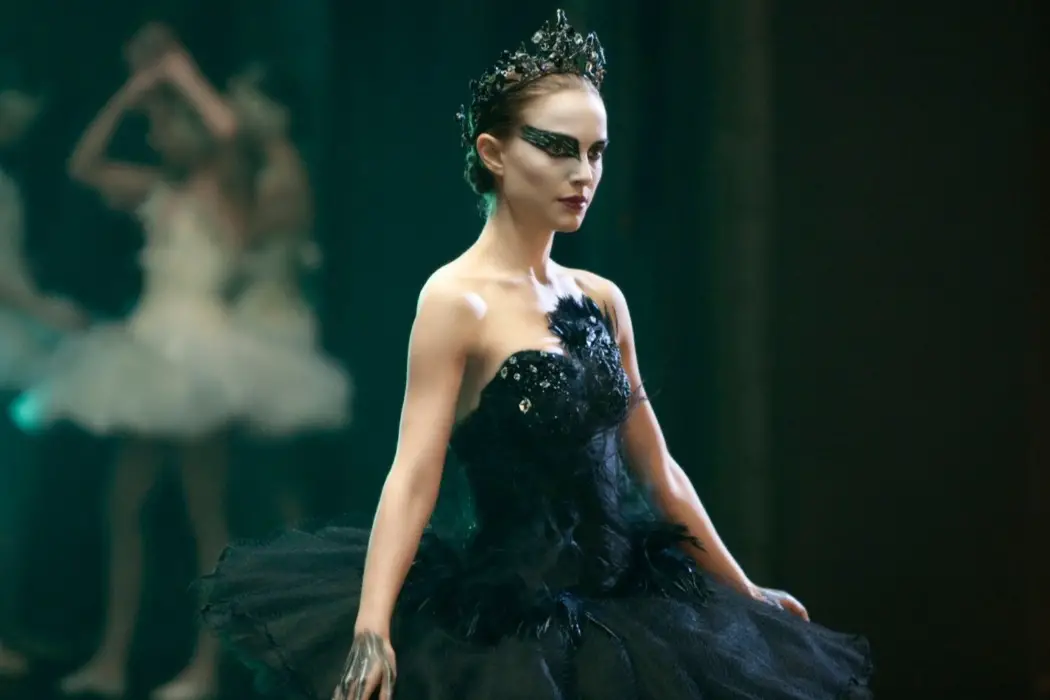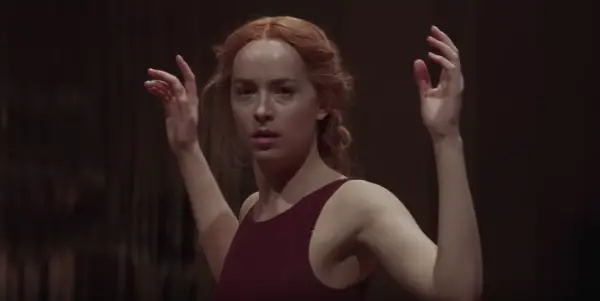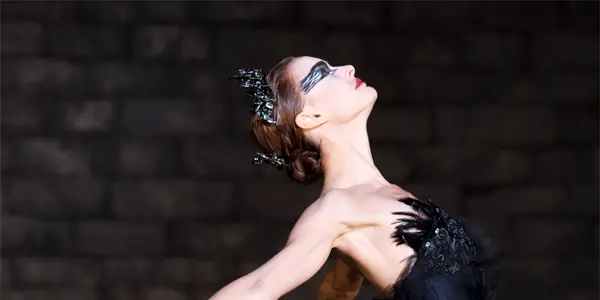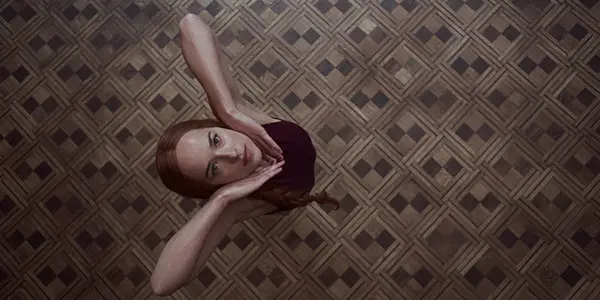BLACK SWAN & SUSPIRIA: Singing The Body Horror Electric

John Stanford Owen received his MFA from Southern Illinois University,…
The curious sympathy one feels when feeling with the hand the naked meat of the body,
The circling rivers the breath, and breathing it in and out,
The beauty of the waist, and thence of the hips, and thence downward toward the knees,
The thin red jellies within you or within me, the bones and the marrow in the bones.
-Walt Whitman, “I Sing the Body Electric”
In Black Swan, Darren Aronofsky chisels away at ballet’s graceful smokescreen, revealing the physical ramifications that happen as dancers master their pliés, pirouettes, and demi-points. Those silk slippers house frayed tendons and twisted toes, painful sacrifices made in the name of elegant perfection – and that surface-level trauma unveils only the initial truth the director wants us to know. With the opening scenes, the film navigates body horror with an almost subdued perspective, but as mania invades and conquers the prima ballerina’s mind, reality becomes blurrier and blurrier. To perform in “Swan Lake,” Nina must transform into a black swan, not in spirit but in fact, and so protruding follicles bubble up to prime her skin for feathers to sprout.
Black Swan found a cinematic sibling in Suspiria. In this 2018 dance/body horror feature, director Luca Guadagnino positions our ear directly beside the sockets where ligaments and sinew pop and crack. We listen to the screeching sound sweaty sternums make skidding across a gymnasium floor. A dancer landing a high jump means hearing tibia bones hammered into kneecaps. The film never allows us to forget that, despite their every physical capability, bodies break. In this way, Suspiria, a loose reimagining of Dario Argento’s beloved 1977 giallo, bears far more resemblance to Black Swan than to its titular predecessor. But the filmic familialness runs deeper than utilizing dance as a storytelling device. These motion pictures showcase an evolution and redefinition of body horror, both as a genre and a concept.

It seems only natural to compare that expansion to the wince-inducing images David Cronenberg made famous, but where Dead Ringers, Videodrome, and Naked Lunch reach for the sky with fast-paced, sideshow gags, Guadagnino and Aronofsky draw out the experience. Theirs is a body horror that happens not with surprise but with slow and deliberate cinematic foreplay. It’s not about how the dancer threatening to expose the witch coven crumples into a human paper wad; it’s about the way urine leaks down her pantleg as her spinal column swivels and snaps. Nor is it about the gashes on Nina’s shoulder blades growing more gruesome each time we see them; it’s about the grating snip the scissors make as she cuts her fingernails to prevent unconscious self-harm.
These directors elevate the body horror genre in a way that reflects the austere reality of a tempestuous world. And that feat takes major sacrifices.
Redefining a Genre: the Aftermath
It’s as though these two directors sit astride a critical seesaw; teetering up and down as one basks in praise, while the other languishes in lackluster ticket sales.
Amid a cornucopia of critical nods and prestigious nominations, Black Swan garnered star Natalie Portman a win for Best Actress at the 83rd Annual Academy Awards. Hardened critics and casual moviegoers alike praised the film for its knockout performances and claustrophobic cinematography. On the other hand, six years later, Darren Aronofsky’s mother! sparked diametrical reactions, sending audiences either to the peak of rapture or the pit of revulsion. No one who saw that film, a biblical allegory that meditates on gun violence and climate change, left the theater with feelings of indifference.
The same year mother! conjured such a mishmash of reviews, Luca Guadagnino’s Call Me By Your Name, with its Italian summer backdrop, six-pack-sporting erotic sculptures, foamy ocean waters, and heart-rending love story, became an award show darling. But, as the critical pendulum swings, these two filmmakers traded spots in audiences’ hearts and minds. As Suspiria sluggishly rolled from coastal screens to Midwestern theaters, the schism occurred again. Some reviews sang dirges, citing how the movie dragged for its two-and-a-half-hour run time and eliminated the blitz of color and scrolling lights that made its forerunner such a visual feast. Other takes praised Suspiria for Tilda Swinton’s triple-role performance and how the film overcame the status of yet another remake tossed atop an ever-growing stockpile of nostalgia-fueled cash machines.

Despite their landing poles apart on the measuring stick of critical assessment, these films check off the same goal: engineering the rebirth of an old idea. The directors created a conscious evolution of body horror, taking the genre from its origins of physical violation and shock factor to a heightened psychosocial plane. Of course, in and of itself, shock factor presents no risk to how a film will be received. A slew of franchise horror pictures have used gore, torture fetishization, and general gross-out factor to sell tickets. Reinvention, on the other hand, almost always creates a gambling scenario,but therein lies the crux of what Suspiria and Black Swan seek to accomplish.
One film uses body horror to unravel the convoluted politics of the mind. The other uses body horror to respond to the brutish politics happening outside.
Swan Songs
In Black Swan’s opening shot, the director introduces our protagonist with a spotlight’s focused beam. She twirls in an automated movement not unlike that of a music box’s pop-up ballerina. Then, for only a few moments, as Clint Mansell’s string-centric score turns more feral, we catch a glimpse of the phantasmagoric imagery to come. No stranger to close-up photography that doubles as a study in the human face, Aronofsky soon drops the audience amid a backstage hullabaloo where we catch fast-paced glimpses of the dancers’ faces, each caked in a thick batter of makeup. Any one of these leotard-clad featherweights might pose a grave threat.
Much of the action takes place inside Nina’s bedroom. A character in her mid-to-late twenties, she still sleeps in a child’s paradise replete with an army of stuffed animals and butterfly wallpaper appearing in every imaginable shade of baby-girl pink. Nina’s helium-tinged voice, and her reliance on her mother as a full time caretaker, reveals how the dancer stays too wrapped up in perfecting her dancing to grow up in any other emotional or practical way. Ballet director Thomas Leroy (Vincent Cassel), whose predatory nature would make him a stock character were the portrayal not so true to modern life, tells Nina her precise and elegant dancing technique makes her the ideal candidate for the virtuous white swan. But the malevolent black swan dances with passion in lieu of perfection, which means Nina must add darker, hypersexualized yang to her innocent, childlike yin.

The transformation from naive ingenue to hedonistic enchantress takes its toll, whittling away at Nina’s mindstate and altering the rules of her reality. To rewire the core element of body horror, Aronofsky dives deeper than the flesh. As Black Swan’s story lurches forward, it’s the brain that becomes tangled-up, more so than the body. But that mutilation spreads outward, turning Nina’s long, ballet-friendly legs to a literal version of a swan’s bent cranny of rubbery bone. “The brain makes an excellent servant, but a terrible master,” according to the ancient proverb, but in this film, that wise old axiom takes on a new, more dangerous form, as if to say that the mind’s turmoil will maim and kill in a fashion every bit as cunning and ruthless as physical infection. The brain’s light goes dimmer and fizzles out, and so the body follows it obediently toward darkness.
In Nina’s career, the swan song performance comes early, and that’s because balancing perfected precision with power-hungry passion bears a heavy toll. Her mortal fate remains ambiguous, but in Aronofsky’s world, that part is an incidental concern. The real question is: what punishments would you inflict to revise your position in life? Attacking the mind and body in tandem, Nina’s transformation lights a fuse at both ends, and when the spark hits the blasting point, her world becomes forever warped.
Burning the Witch
Guadagnino places us in 1977 Berlin, some years after the fire-bombings, human science experiments, gas chamber executions, and black-charred bodies left Germany and the rest of Europe in a frenzied state of sociopolitical crisis. As the country scrubs at the stain fascism left, the Red Army Faction, a group of armed leftist radicals, hurls makeshift petrol grenades in the streets, and even while bullet shells plink against the pavement, no one bothers asking questions. And this setting—the revolving door of human devastation—serves as the landscape wherein every element of the mise-en-scene holds something sinister lurking inches outside the camera frame.
All the upheaval outside provides only the background noise. We witness a politically charged and pivotal moment in history reach a blood-soaked crescendo, but in this narrative trek, terror begins at home. That’s where much of the action takes place, a home, but the true setting lies not so much in the dormitory where the dancers sleep or the studio where they choreograph their moves. The horror resides inside the body, the ultimate headquarters, and the hazardous demands of dance stretch its limits.

In what is perhaps the film’s most talked-about scene, the body discovers its limits in extremis. To close the first act, former Mennonite turned dancer expat Susie Bannion (Dakota Johnson) performs a rendition of the contemporary number “Volk.” Composer Thom Yorke’s mournful synth fills the room as Susie pivots and leaps and sweeps her legs across the studio floor. Meanwhile, cross-cutting reveals how her movements control the body of another dancer, Olga, a student who had stormed away from the dance studio/witch coven after christening the place a “box of rabies.” An unknowing puppet master, Susie’s jutting moves fold the attempted escapee’s body into a dilapidated pile of bone and loosened, flapping skin, shattering both arms, unhinging her jaw, breaking the legs and the ribs, and to tie the whole production up with the grimmest bow possible, her backbone twists and twists until it falls to pieces.
The scene redefines body horror not so much in how Guadagnino elongates the sequence with the uber-intimate minutiae of dripping spinal fluid and a voided bladder, but in how it ushers personal autonomy into the equation. What happens when someone loses control of their personhood and another takes carte blanche ownership over a body that doesn’t belong to them? Suspiria answers that question. Looking back at antiquity, when religious zealousness provided the only litmus test of virtue, Suspiria reminds us what happens to those who shatter the puritanical masquerade: from Würzburg to Salem, tens of thousands, predominantly women, died with their wrists bound inside a tower of flames. In this regard, Guadagnino raises body horror onto the political stage, showing how, when a person claims ownership of their body and resists the control of third parties, someone with malicious intent will wish to see them burn.
Final Thoughts: The Marrow of the Bones
Stationed on his deathbed, world-renowned journalist and polemicist of religion Christopher Hitchens penned a short book, Mortality, that chronicles his treatment experience with respect to esophageal cancer. That memoir ends abruptly, at only 128 pages, after the disease shut down the author’s organs (the final pages showcase half-formed notes written in what appears to be a pharmaceutical daze.) The book is sad, for sure, but not maudlin. Never one to shy away from unblinking candor, Hitchens reminds the reader on more than one occasion that “I don’t have a body. I am a body.”
Those two sentences swirled around inside my brain as I rewatched Suspiria and Black Swan. And that’s because the author reveals a sentiment that stretches beyond the nuts and bolts of mortality. The proclamation, when applied to the way we react to narrative art, tells us that body horror is not a cinematic invention. In fact, it’s not even an invention at all – the body’s habit of breaking has always been there, a shadow forever hooked to our personage, and so it becomes a subject filmmakers must tackle in the quest to uncover truth.
When a malicious entity takes up residence within a person, whether it’s a malignant cancer or an inescapable dragnet of mental illness, it becomes clear that body horror originates more from science than fiction. The facts create it, but the films help us deal with it, steering the quiet reality of disease into more fantastical territories. In these most turbulent times, when the dizziness of the news cycle gives us a binary choice between staying informed and feeling happy, the way filmmakers present body horror must evolve.
In a similar fashion to how Rosemary’s Baby metaphorized abortion rights, the body genre has become a coping mechanism and a critical mirror held up to the today’s barbaristic zeitgeist. Black Swan brought life to the skeleton of a new conception and Suspiria applied the muscles and skin. The idea of body horror as a deflection of pain dives deep enough that you can find it in “the naked meat of the body, the thin red jellies, the bones and the marrow of the bones.”
Other than the use of dance as a narrative device and redefining body horror, do you see any other way in which these two films connect?
Does content like this matter to you?
Become a Member and support film journalism. Unlock access to all of Film Inquiry`s great articles. Join a community of like-minded readers who are passionate about cinema - get access to our private members Network, give back to independent filmmakers, and more.
John Stanford Owen received his MFA from Southern Illinois University, where he also taught English courses. When JSO is not penning reviews and essays on cinema, he's reading and writing poetry, walking with his dog, or dancing to Radiohead.













